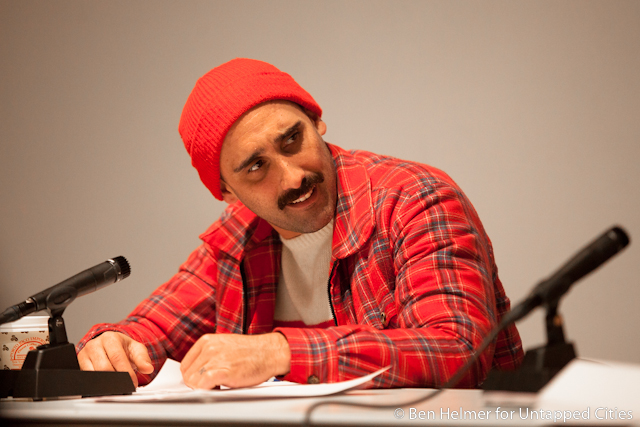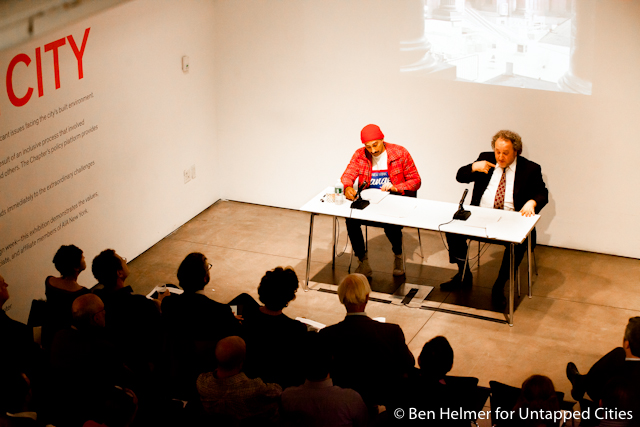 Image by Ron Ziel
Image by Ron Ziel
While picking up a friend from Penn Station in 2001, playwright Justin Rivers was drawn to framed photos of a grand train station hanging on the wall. “Oh my god,” he exclaimed, “this must be some place in Europe.” It was at that moment he moved in closer, reading the words “Pennsylvania Station.”
The outrage of this demolition isn’t news to most of us in New York, although the exact picture of this bygone structure might be. The 1963 destruction became the focus for Justin as he began writing The Eternal Space. Photography faded across the screen during Wednesday night’s performance, bringing a face to the ghost left behind by this infamous event.

The lives of both characters from Justin’s play only furthered the dialog already ignited by those pictures, as the AIANY Center for Architecture followed up with a panel of Penn Station’s past and future.
Norman McGrath, an Irish-born engineer and photographer of the destruction, was one of those panelists to witness this past first hand. He told the audience of the scene as the demolition began. “The exterior of Penn was very hard to break down. Only little chips came off at first… the engineers were worried.” It eventually did come down. The interior, unlike the tough exterior, was composed of fake stone, and crumbled much more easily.
While Norman created the largest collection of photographs of the destruction, there are many more out there. “Penn Station has been so well documented, ” Justin Rivers told us, “but most of the public doesn’t know it.” This was part of the motivation behind the AIA event: to bring awareness of the documentation available to us.

The 1963 destruction was only one piece, however. With news of the final 10-year extension for the lease of Madison Square Garden, the discussion inevitably shifted from the past to the future of the now unpopular station. Lorraine Diehl, author of The Late Great Pennsylvania Station, described the current station as “not fit for civilization,” while pointing out a future Penn Station should not pander to the past. To do so now, she said, “would be to ‘Disney-ify’ the station.’ It would be a building that looked like the real thing, but saw none of its history.”

Some spoke of bringing a civic space, sort of “Bryant Park meets Grand Central,” while others addressed the topic of High Speed Rail. Lorraine noted one commonality of all recent proposals was bringing light back into the equation.
Raising a less voiced viewpoint, Lorraine Diehl also addressed the demonification of MSG. “That needs to change. We should show MSG that they can still be a part of the picture, perhaps a ‘brisk walk from Penn’, ..without being removed [from the picture entirely].”
If you had listened closely, you might have heard one line of The Eternal Space echoing throughout the night: “We will not be judged by the landmarks we created, but by those we destroy.” Justin’s play made our past all the more tangible, perhaps even haunting to some. Whatever the motivation, one thing was clear: everyone in the room seemed to be attempting some sort of redemption for the architectural sins of our past.

Writer Justin Rivers (left) and Photographer Norman McGrath (Center) listen to author Lorraine Diehl (Right) speak during their panel on the destruction and future of Penn Station at the AIANY: Center for Architecture’s event & play, The Eternal Space.

The two actors (left / right) who performed Wednesday night’s reading of play, The Eternal Space, pose with the narrator (center).




Norman McGrath (left) helps hang several of his prints documenting the destruction of Penn Station.

Get tickets to our upcoming tour of the Remnants of Penn Station:





